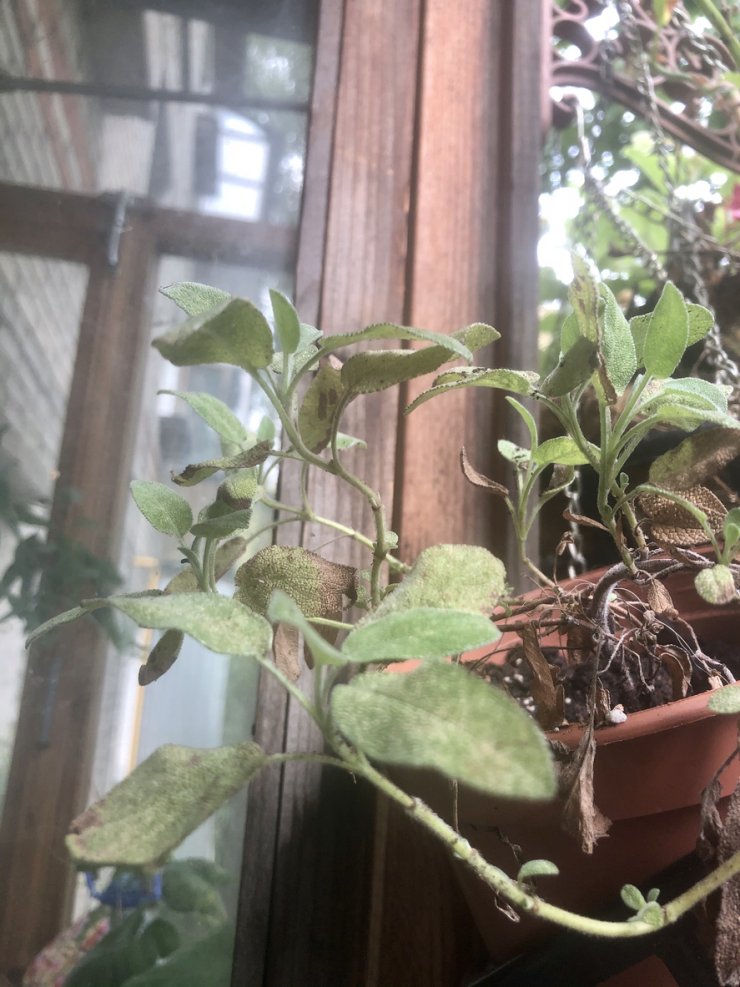
Unhealthy sage plant
Sage plants are relatively disease-free, but there are a few that can damage your plants. Most are caused by fungi that can spread through the soil, water, air, infected tools, animals, and even gardeners themselves.
Spot diseases on your sage plants sooner so you can treat plants before they are destroyed by disease and can successfully manage symptoms. Here is a three-step approach to keeping vigilant about the presence of sage plant diseases:
- Research the risks. Find out about sage diseases that are prevalent in your geographic area. Moist and rainy climates can contribute to fungal diseases. When possible, choose sage varieties that are hardier and more disease resistant.
- Examine plants daily. Check your sage plants every day to be sure no disease symptoms are present or emerging.
- Spot diseases early. Catch and treat disease quickly so your plants can recover and thrive.
Sage diseases can affect the leaves, stems, and roots. Here are possible disease symptoms to look for to spot potential infection:
Sage leaves:
- rusty spots or blotches
- yellowed or spotted/blotched foliage
- dusty spots on top of leaves
- white or rusty bumps on the bottom of leaves
Sage stems:
- softness or mushiness
- turning brown
Sage roots:
- limp, yellowing leaves
Make your own natural disease and pest control spray with benign materials. Mix 1 tablespoon of baking soda, 1/2 teaspoon of a mild dish detergent, and 2 1/2 tablespoons of olive oil in a gallon of water to make a solution that will repel all kinds of bugs, as well as a fungicide for blight and mildew on the sage plant leaves. Shake it well in your bottle before spraying, and repeat every week for it to be continuously effective.
We’re believers in not using toxic materials in the garden—they can hurt the plants, hurt the soil, damage the environment, and harm you.
Common Sage Diseases
Alternaria Leaf Spot: These are small rusty spots or blotches with white or grey centers that you’ll see on the top of the leaf. Warm and humid weather make it worse. Remove infected parts and prune to improve air circulation.
Damping Off: Caused by a fungus in moist soils, this is when your sage suddenly wilts and dies for no reason. It could be because the soil is too moist, or because you have too much nitrogen in your soil. Sage can thrive in most conditions and doesn’t require excessive watering or fertilizer.
Mint Rust: When you see small white spots under the leaves that are raised before turning red or brown, you may have mint rust. This is from too much overhead watering. You can avoid this spread by separating plants in the mint family.
Powdery Mildew: This disease will look similar to how it will on squash plants. You’ll see an extra white or grey fuzz on leaves, and it will slowly kill the plant. Overwatering from overhead can cause this, and a lack of air circulation. Try pruning to add air circulation and reduce watering or transplant to a drier area.
Septoria Leaf Spot: Small grayish-brown spots on leaves that eventually turn black and die. The spots may also have a red color to them. Like most sage diseases, this can be avoided by watering less and providing more air circulation in your plant.
Preventive Measures to Avoid Sage Plant Diseases
Try some of these techniques for avoiding sage diseases in the first place.
Give your plants space. Because sage thrives in dry conditions, it needs space to ‘air out,’ especially after watering. Crowded plants are more likely to retain moisture which encourages fungi to grow, so proper air circulation is vital to healthy sage plants. More space also allows the sun to reach more of the plant, helping to evaporate excess water. Avoid letting water pool beneath the plants.
Improve your soil composition. Before planting your sage, add a good amount of compost or organic matter to improve the soil. Extra nutrients and good aeration help grow stronger plants that will resist disease and infection. Make sure the soil composition allows for plenty of drainage.
Water your garden properly. Don’t underwater or overwater your sage plants. By keeping a regular watering schedule, you’ll keep your plants vibrant and healthy. Overwatering and watering directly on the plants—instead of the preferred watering method, directly at the stem on the soil—leads to consistently wet conditions, which allows bacteria, fungi, and viruses to thrive and multiply.
Destroy infected plants. Throw away or burn infected plants. Don’t keep infected plants over the winter in your garden, and don’t throw them on your compost pile. Disease-ridden plants, even when dead, will spread the disease to other plants or even your soil.
Have you had problems with diseases attacking your sage plants? What types of problems do you regularly face with your sage? Please tell us how you treat and prevent diseases from destroying your sage crop.


 Previous
Previous

